
State of the Hiring Market – 1st Quarter, 2023
Looking for a job in 2023?
Need to fill an important position?
Here’s where the job market stands for both job seekers and employers. The job market in Australia is affected by economic changes, new technology, and what job seekers want. After over a year of candidates calling the shots, the tables have turned and employers are seeing a rebound in the balance of power. One of the most important trends is that candidates are less in demand now despite unemployment remaining low at 3.5%. This means that candidates need to adjust their expectations in terms of salary, bonuses, benefits, and flexibility.
Job Market Cools
The cooling trend is linked to ongoing economic uncertainty, rising interest rates, inflation, and a shift in priorities among job seekers. Job advertisements fell 5.2% in September 2022, and job applications per job ad have risen 10.3%, the greatest increase since April 2020. Candidates who wish to stay competitive in the market need to realign their expectations. It is essential to note that the cooling trend is not a blanket trend across all industries, and some industries, like sustainability, cyber security and sales are still in high demand.
Furthermore, clients are finding it slightly easier to find staff, as people are looking for jobs and are more open to change and returning to the office. Quality work is essential as companies have a healthy balance sheet and no room for under-performers. Employers will reward great operators who can prove their worth but don’t expect a crazy signing bonus. Productivity and ROI are the metrics of the day. This shift reflects broader economic trends that are tightening up the labour market and forcing candidates to broaden their horizons. Employers should tailor their recruitment ads to reflect these changes to attract top talent.

Flexible work is a non-negotiable
However, employers must stay in touch with what employees want. According to insights from LinkedIn’s Global Talent Trends, employees still highly value work-life balance, flexible work arrangements and up-skilling. Some of the drastic changes to how we work leftover from the pandemic are still relevant. Demanding people come into the office 5 days a week, 9 to 5 will turn off most candidates. According to SEEK, more people search “work from home” than any other term. Embracing work from home (at least part-time) and flexible schedules has been a boon for most employers. Data from Gartner shows that flexibility is the top reason for improved employee productivity.
 Another area of concern for employers is the growing rates of absenteeism due to sickness among employees. Illness, injury, and sick leave has increased by 85,900 (or 16.5%) in December 2022. This is over 50% higher than the average level recorded each December over the last eight years. Obvious concerns about employee wellness should dominate the conversation amongst HR teams. Employers need to consider how to keep their workforce well and able to perform.
Another area of concern for employers is the growing rates of absenteeism due to sickness among employees. Illness, injury, and sick leave has increased by 85,900 (or 16.5%) in December 2022. This is over 50% higher than the average level recorded each December over the last eight years. Obvious concerns about employee wellness should dominate the conversation amongst HR teams. Employers need to consider how to keep their workforce well and able to perform.
Employers should focus on building a strong employer brand that emphasizes their values and commitment to employee growth to attract and retain top talent in the market. Employers will need to balance an increased supply of employees with offering competitive compensation packages and other benefits to land top talent.
Up-skilling may be required
Job seekers, on the other hand, face the challenge of showcasing their skills and experience in a way that shows they fit the organization and the role. They need to be open to new opportunities and willing to negotiate on compensation and other benefits to remain competitive in the market. Job seekers should also be prepared to build new skills to be in-demand and be aware that many employers are unwilling to train from scratch. Look for creative ways to demonstrate your skills and potential cross over with new roles.
Market slightly favors employers, but employee concerns must be addressed for success
In summary, the Australian employment market is a dynamic and ever-evolving landscape that requires both employers and job seekers to stay informed and be ready to adapt to new developments. This season the ball is in the court of hiring managers. But they must toe the line and not jeopardize the interest and attention of the most qualified applicants. Employees should offer flexibility where they can as this not only attracts employees, but is a significant indicator of their overall productivity, wellness, and happiness in a role. By staying ahead of the curve and proactively addressing emerging trends and challenges, both employers and job seekers can evolve in this market.
